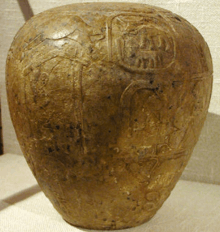Naos (shrine)
| ||||
| Shrine (Naos)-O18 (O21-rectangular) in hieroglyphs |
|---|
The naos is a symbol used in ancient Egypt. In Egyptian hieroglyphs, two common versions exist of the character translated as "naos": the older one dating to the Old Kingdom era, and a common rectangular form from the New Kingdom and later.
In Egyptology

The naos as a small shrine is known in its typically Egyptian form since the beginning of Ancient Egyptian history. It eventually came to be represented as an Egyptian hieroglyph.
Some of the oldest examples are from the labels of the early pharaohs. The Early Dynastic king Narmer is shown on the Narmer Macehead seated in a naos.
A statue of a person holding a little naos, such as the statue of the Ramesside overseer of the treasury Panehsy, is called naophorous.[1] The earliest examples of such statues date to the 18th dynasty.[2]
Naos-doubled, the Pavilion hieroglyph
|
|

The early Old Kingdom labels, for example Pharaoh Den, portrayed him in a side view in his naos shrine. An example of the combined, opposed, view with the two crowns, is the lintel of Senusret II, 12th dynasty, 19th century BC. It shows the naos curved roofs of each half of the pavilion hieroglyph.
References
See also
| Wikimedia Commons has media related to Naos (hieroglyph). |
| Wikimedia Commons has media related to Naos-rectangle (hieroglyph). |